This year's BreMarE Day celebrating Marine Ecology placed the emphasis on the marine resources we are already using or are about to exploit and the pros and cons of human use. The Ocean Sciences Colloquium took place 23 November 2016 at the Center for Research and Education of the University of Bremen.
 Prof. Wilhelm Hagen, Vice Dean and Director of the Center for Research and Education at the University of Bremen and host of the event welcomed the participants, students and colleagues mostly from northern German places of learning and research.
Prof. Wilhelm Hagen, Vice Dean and Director of the Center for Research and Education at the University of Bremen and host of the event welcomed the participants, students and colleagues mostly from northern German places of learning and research.
Prof. Andrea Koschinsky of the Jacobs University of Bremen gave an overview talk titled "Deep-Sea Mining: Perspectives and Environmental Impact". Deep-sea mining has recently come more into public focus. Rising prices for rare earth minerals used in wind turbines, smart phones, solar panels and other appliances have renewed interest of mining companies.
Even though deep-sea mining is not expected to be profitable in the next 10 or 20 years, depending on the development of metal prizes, considerations in favour are several, such as diminishing returns from land-based mines, avoidance of toxic drainage on land, mobile infrastructure that would be reusable in different places, avoidance of political interference and some types of conflict.
The International Seabed Authority (ISA) created under the UN Convention of the Law of the Sea and responsible for overseeing exploration activities and mining in international waters has only a small team. In addition to licences issued by national governments for exploration and mining within their exclusive economic zones (EEZ), ISA has issed some 25 licences for exploration in the high seas. A code for mining in international waters is still under development, while some governments may move ahead faster in the tension between short-term economic gain and environmental protection..
The licences in the high seas come with an obligation for 15 years of preparatory research and reporting of results. The Clarion-Clipperton Zone (CCZ) in the Central Pacific is one of the meeting areas of tectonic plates with high grade ores under study.
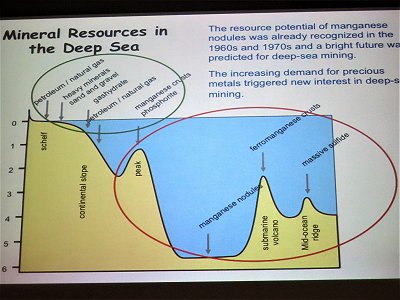 The research results so far suggest that the formation of small nodules rich e.g. in manganese on the surface of submarine plains take two to three million years. Ferromanganese crusts accumulate even more slowly, over some 20 million years. Exploiting these would involve breaking up these crusts with the risk of creating extensive plumes, which may smother the ecosystems within their reach.
The research results so far suggest that the formation of small nodules rich e.g. in manganese on the surface of submarine plains take two to three million years. Ferromanganese crusts accumulate even more slowly, over some 20 million years. Exploiting these would involve breaking up these crusts with the risk of creating extensive plumes, which may smother the ecosystems within their reach.
A second major focus are massive sulfide deposits associated with submarine volcanoes and hydrothermal vents with high grades ores, such as two to ten per cent copper, five to 20 per cent zinc, gold, silver and indium.
The Canadian mining firm Nautilus Minerals Niugini Ltd has e.g. received a green light from the government of Papua New Guinea to mine about 50 kilometres offshore in the Bismarck Sea, at a depth of 1.6 kilometres in its exclusive economic zone. This triggers concern among many scientists as we know so little about the deep sea and its fragile ecosystems.
Thanks to a research cruise off Peru in 2015, the site of disturbances 16 years earlier could be checked. The plough tracks were still visible in great detail, an indication that a new equilibrium would take a very long time to develop,
For a summary of findings of the MIDAS project funded under the European 7th Research Framework Programme that provides further results click here.
Biotechnology of Marine Natural Products
 Prof. Antje Labes of the University of Flensburg focused her talk on the challenges of discovering active compounds in marine organisms that might be useful in new generations of medecines or other applications. Stimulated by the finding that prialt, a substance developed from a marine snail and 10 times more powerful than morphine in pain management, but without the side effects of morphine, the race was on to find new molecules.
Prof. Antje Labes of the University of Flensburg focused her talk on the challenges of discovering active compounds in marine organisms that might be useful in new generations of medecines or other applications. Stimulated by the finding that prialt, a substance developed from a marine snail and 10 times more powerful than morphine in pain management, but without the side effects of morphine, the race was on to find new molecules.
A wide-spread approach was to use bacteria, such as Pseudomonas, to produce quantities of the basic complex structure of e.g. an anti-cancer component or inhibitors of physiological pathways of diseases. If the bacterium was successfully induced to produce the molecule, the next step would then be laboratory synthesis to complete the active substance. But researchers were finding that the road from discovery to a marketable product was long and thorny.
Step one in this approach was to find a suitable culture medium so that the bacteria would actually produce the desired component. Culture media are specific for each taxon and the environmental conditions that are being mimicked to trigger the production.
This search is supported by building libraries of compounds. Despite these efforts to improve discovery, the lack of basic knowledge it is still very much at the stage of trial and error.
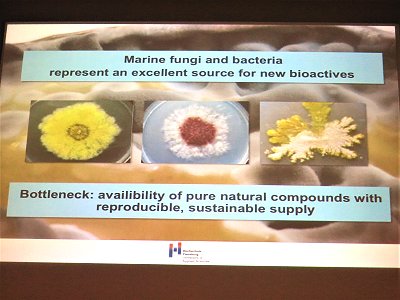 Genetic markers are often used to enhance the predictability of the active substance and its production, but again, the gaps in understanding often result in only partial success.
Genetic markers are often used to enhance the predictability of the active substance and its production, but again, the gaps in understanding often result in only partial success.
The secondary metabolites of an active component are usually sensitive to environmental conditions in the laboratory. In order to become more efficient in scaling up the producesses it seems most promising to study them in nature and then try to copy without the need for large-sized catalysers which would not fit into laboratory-based bacterial helpers such as Escherichia coli.
These few sketches illustrate already how difficult the search and production processes are. A concerted effort into basic research to reduce the costly hit and miss approaches is likely to pay off more than more trials that are even often difficult to interprete because of the large number of variables and the difficulties to establish "simple" cause-effect relationships.
Resources in European Seas (Status of major fish stocks)
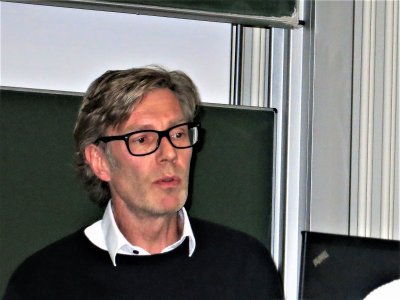 Prof. Gerd Kraus of the Thünen Institute in Hamburg spoke about the resource situation in European seas. He started out with an overview of the global fisheries and aquaculture sectors taken from the last FAO report on The State of World Fisheries and Aquaculture 2016.
Prof. Gerd Kraus of the Thünen Institute in Hamburg spoke about the resource situation in European seas. He started out with an overview of the global fisheries and aquaculture sectors taken from the last FAO report on The State of World Fisheries and Aquaculture 2016.
He highlighted that fisheries and aquaculture sustained the livelihood of about 10 to 12 per cent of the global population with total aquatic food production reaching about 150 million tons. The revenue at point of first sale was estimated at US$ 129.2 billion. Fisheries products were among the most traded commodities.
Of the 93.7 million tons of produce from capture fisheries 80 million tons were from marine waters. Aquaculture production for food amounted to about 66.6 million tons, mostly in Asia, while algae production reached 23.8 million tons. Half of the aquatic food for human consumption now came from aquaculture.
He then continued with some indicators for Europe. Within the EU, the fisheries and aquaculture sectors accounted for approximately 414,000 jobs, mostly in rural and outermost regions. Employment in capture fisheries was 116,000 persons, with 60 per cent of these in Spain, Greece and Italy. The annual production reached about six million tons worth Euro 30 billion. Unlike the global aquaculture trend production in Europe was mostly stagnant, though of high per-unit price. More than 70 per cent of the consumption of fisheries products in the EU depended on international imports.
Fishing capacity decreased by about two per cent per year in recent times. The 85,000 strong fishing fleet in 2015 was composed mostly of small boats. Only a few big companies are profitable, while the economic situation for all others is rather tight, if not outright negative.
As for fisheries management in the EU, he was rather cautious if not pessimistic that it would improve in the short term. This, according to Prof. Kraus, is because striving for maximum sustainable yield (MSY) was not a good objective due to the multi-species nature of many fisheries. He also feared that while the discard ban was well-intended, it would increase false declarations and other tricks to avoid the negative economic effects. The management machinery was quite unwieldy and had difficulties handling the multiple and often competing demand for space and resources not only from intensive fishing, but also wind farms, gas and petroleum extraction, submarine cables, recreation, commercial traffic and much else.
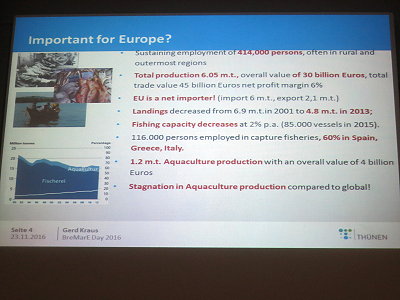 The grand challenges in the longer term according to the speaker were climate change, multi-use management and sustainable food production from the ocean.
The grand challenges in the longer term according to the speaker were climate change, multi-use management and sustainable food production from the ocean.
Climate change: The upper 2000 meters of water in the ocean took up 90 per cent of the temperature increase engendered by greenhouse gas emissions. The temperature increase goes hand in hand with acidification, altered water mass transport, and frequent extreme events will affect marine ecosystems. We should expect more changes in the distribution patterns of marine organisms, globally reduced productivity, biodiversity and ecosystem services to name but the most obvious effects.
Multi-use management e.g. in the heavily exploited German North Sea segment struggles to accommodate 4000 hours of bottom trawling, wind installations for 25,000 MW wind energy, 900 ships sailing in the North Sea at any one time and more.
Ecological processes and human interventions operate at different scales and our unterstanding of cumulative effects on ecological and socio-ecological systems is still in its infancy. Cross-sectorial research is therefore needed to develop governance and management systems that can cope with multiple human and other demands and finding acceptable trade-offs between justice, prosperity and systemic sustainability.
Feeding humanity without destroying the ecosystems we rely on: As it seems that there is an upper limit of food the ocean can provide on a sustainable basis through capture fisheries, we need to explore how to feed humanity projected to reach or even surpass 10 billion people in the next few decades. Will the expected gap be filled through aquaculture? Prof. Kraus thinks that global strategies should look at fisheries and aquaculture in more integrated ways, consider the working of markets and approach the management challenge more from the perspective of the end product than the resources per se.
Multitrophic aquaculture
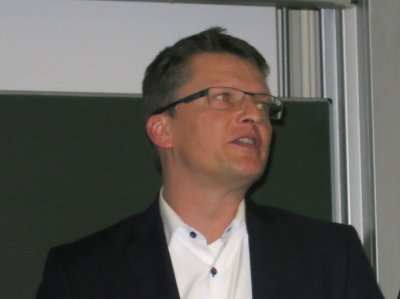 Prof. Bela Buck of the Alfred Wegener Institute for Polar and Marine Research (AWI) in Bremerhaven focused his talk on integrated multitrophic aquaculture (IMTA). Aquaculture is the production of aquatic organisms under controlled conditions. The span of cultured organisms is wide, seaweed, molluscs, crustaceans, fish and others. Europe's main aquaculture products are blue mussels, sea bass and salmon. Mussels are filterfeeders low in the food web, the fish species are carnivores much higher in the trophic web.
Prof. Bela Buck of the Alfred Wegener Institute for Polar and Marine Research (AWI) in Bremerhaven focused his talk on integrated multitrophic aquaculture (IMTA). Aquaculture is the production of aquatic organisms under controlled conditions. The span of cultured organisms is wide, seaweed, molluscs, crustaceans, fish and others. Europe's main aquaculture products are blue mussels, sea bass and salmon. Mussels are filterfeeders low in the food web, the fish species are carnivores much higher in the trophic web.
Europe plays only a modest role on the global map of aquaculture production, which is dominated by Asia, particularly China. Good environmental conditions are increasingly recognised as key for future production. Several international organisations have therefore developed guidelines to reduce the ecological footprint of aquaculture. Several approaches are under development or further refinement to combine stable production with good environmental status.
IMTA or polyculture is one such approach. An example is a combination of vegetable and fish production, where fish tank effluents water and fertilise vegetable plantation. The biggest effect is in the vegetable segment, but the combination produces less waste and has higher ecological and economic stability.
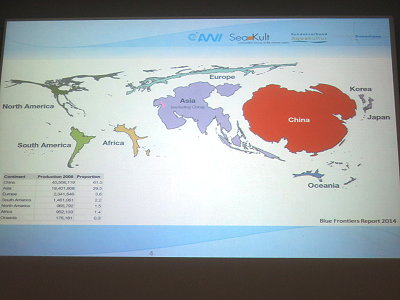 Another example completely located in the sea is fish cultivation, such as turbot (Scophthalmus maximus) with downstream mussels (Mytilus edulis), oysters (Ostrea edulis, Crassostrea gigas) and other filter feeders and algae (e.g. Palmaria palmata, Saccharina latissima) as the final cleaning-cum-production step. The filter feeders take up the particulate matter of the waste water of fish tanks, while the macroalgae absorb the disolved nutrients.
Another example completely located in the sea is fish cultivation, such as turbot (Scophthalmus maximus) with downstream mussels (Mytilus edulis), oysters (Ostrea edulis, Crassostrea gigas) and other filter feeders and algae (e.g. Palmaria palmata, Saccharina latissima) as the final cleaning-cum-production step. The filter feeders take up the particulate matter of the waste water of fish tanks, while the macroalgae absorb the disolved nutrients.
This is a fertile field of sustainability research that can learn from traditional polyculture e.g. in China, but also from modern forms of polyculture with different site-adapted species combinations. The ultimate lynch pin is always to make it not only work in terms of good use of different ecological niches in the trophic network, but also ensure finanial viability.
Moderated discussion
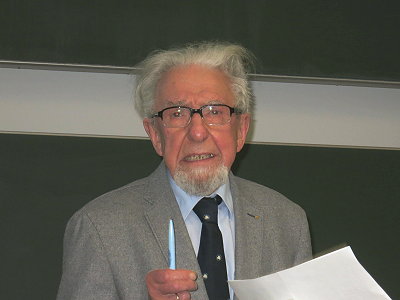 Prof. Gotthilf Hempel moderated the discussion encouraging the participants to comment on each single presentation and on cross-cutting issues.
Prof. Gotthilf Hempel moderated the discussion encouraging the participants to comment on each single presentation and on cross-cutting issues.
The concern running through many questions and comments was how to use the ocean and its resources in responsible and sustainable ways. An even more radical question was, whether maximising resource use was even the right question. At a time, when Western industrialised societies waste 40 per cent of the available food, not only could all currently living humans be fed properly, but demographics are not posing as much threat as wasteful practices and social injustice do.
So, a key question was whether we would want and be able to maintain our luxurious lifestyles and continue to increase extraction of resources or whether we had other options to reduce wastage first and still live good lives.
The recent study on the status of 120 species of marine organisms in 397 stocks in European waters showed that five million tons of more fish could be sustainably produced if populations were allowed to recover to healthy sizes that can produce 90 per cent of MSY on a stable basis. That would be almost as much as current imports and would largely obliviate the need for often conflictual overseas fishing of European fleets, a boon for the climate and resources elsewhere.
Similar considerations could be brought forward in relation to deep sea mining. The scarcity of rare earth elements is largely the result of linear production processes which are always hungry for more resources and produce large quantities of costly waste posing public health hazards in Europe and in developing countries, where many discarded products end up. Redesigning production processes under the concept of the circular economy, much like the way nature operates, would create another type of research and innovation agenda. That should be possible though a huge challenge, but which looks like it would make us fit for the future.
Photos are by Cornelia E Nauen.








